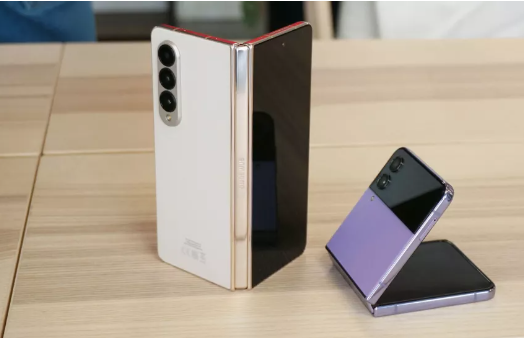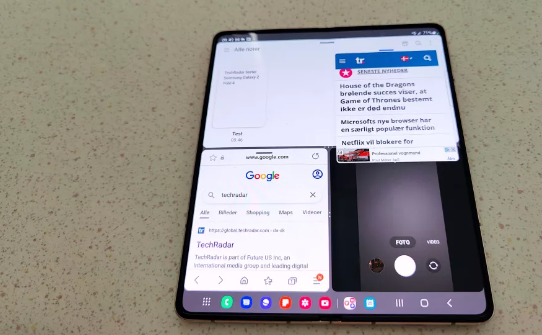There are two main types of foldable phones available today. The first type resembles the old flip phones our ancestors used, folding up into a compact size. The second type, exemplified by Samsung, opens up to reveal a tablet-sized display. Both the Samsung Galaxy Z Flip 4 and the Motorola Razr Plus 2023 fall into the former category. These phones offer a fun and compact design, and they are also more affordable than their larger foldable counterparts.
On the other hand, the Google Pixel Fold and the Samsung Galaxy Z Fold 4 belong to the latter category, resembling folding tablets rather than traditional smartphones. These devices are substantial in size, weight, and cost. In fact, in absense of iPhone Fold, these “Fold” phones are the most expensive smartphones currently available. To put it into perspective, one could purchase the best iPhone on the market, even with the addition of 1TB of storage on an Apple iPhone 14 Pro Max, and still spend hundreds less than the cost of a Google Pixel Fold.
Google folds the Fold in the right direction
Both the Google Pixel Fold and Galaxy Z Fold 4 feature a 7.6-inch interior display. However, these two phones appear significantly different when it comes to their interior screens. The Galaxy Z Fold 4 is notably taller, while the Pixel Fold is shorter and wider. This difference in appearance is due to Google’s decision to rotate its screen 90 degrees, which is a smart move that Samsung missed.
The Pixel Fold is highly functional whether it is open or closed. It boasts a 5.8-inch external display, which is actually larger in area compared to the 6.2-inch screen on the outside of the Galaxy Z Fold 4. The Pixel Fold achieves this by having a wider aspect ratio, while the Z Fold 4 has a very tall and narrow screen.

The external display of the Galaxy Z Fold 4 has an aspect ratio of approximately 21:9, while the Pixel Fold is closer to 17.5:9, making it much wider. As a result, the Pixel Fold provides more than half an inch of extra screen space and a more comfortable width.
The narrow display of the Galaxy Z Fold 4 is not ideal for regular smartphone use. Web pages appear too narrow, resulting in smaller text and less informative pages. This quickly prompts users to open the phone and utilize the larger screen, which feels more natural. On the other hand, the Pixel Fold’s wider screen provides a better viewing experience, making apps look great and reading easy.
Interestingly, both Samsung and Google have chosen to fold an internal display of the same size. However, by folding on a different axis, Google has achieved a much wider and more visually pleasing aspect ratio for its outer display. Overall, the Pixel Fold offers a superior display experience with its wider and more functional screen.
The Pixel Fold has a camera that isn’t the worst
Both Google and Samsung are well-known for producing high-quality camera phones. However, when it comes to the Galaxy Z phones, they seem to lack the same level of imaging quality as other Samsung flagship devices. In fact, the foldable phones take the worst photos out of any expensive Samsung phone on the market. They don’t even come close to the exceptional photo capabilities of the mighty Galaxy S23 Ultra, which we consider to be the best camera phone available.

Both Google and Samsung are well-known for producing high-quality camera phones. However, when it comes to the Galaxy Z phones, they seem to lack the same level of imaging quality as other Samsung flagship devices. In fact, the foldable phones take the worst photos out of any expensive Samsung phone on the market. They don’t even come close to the exceptional photo capabilities of the mighty Galaxy S23 Ultra, which we consider to be the best camera phone available.
On the other hand, Google has already established a reputation for relying on advanced software techniques to enhance imaging. As a result, even their most affordable phones are capable of capturing great photos. The main camera on the Pixel Fold is on par with that of the Pixel 7, and its zoom capabilities are comparable to the Pixel 7 Pro with its 5X telephoto lens. This places the Pixel Fold somewhere in the middle in terms of camera capabilities within Google’s lineup, rather than being at the bottom.
What sets the Pixel Fold apart from the Samsung Z Fold 4 is the inclusion of the Tensor G2 chip and the exclusive photo editing tools that Google offers on its Tensor devices. While Google’s Tensor chips may not have been a standout feature overall, the photo editing tools they provide are truly remarkable. Features like Photo Unblur and Magic Eraser are some of the most impressive smartphone features available, and they are especially enjoyable to use on the large display of the Pixel Fold.
Keep it simple to get more done
Both the Galaxy Z Fold 4 and Pixel Fold are designed to enhance multitasking on their large internal displays. However, the Pixel Fold has a more limited multitasking feature, which may actually work to its advantage. On the Pixel Fold, users can only run two apps side-by-side, without the option to have multiple tiled apps or floating bubbles on the screen.
On the other hand, Samsung phones, particularly the Galaxy Z Fold 4, allow users to open numerous apps simultaneously. Users can have up to a dozen apps running in shrunken windows, side-by-side, and as pop-up buttons. Moreover, there are side panels that can be accessed from a hidden side tab, and users can even utilize the S Pen to write sticky notes on top of everything.

That’s a lot of apps open at one time on a smartphone (Image credit: Peter Hoffmann)
However, these features can lead to a somewhat chaotic user experience. They are buried deep within the phone’s settings, specifically under Advanced Settings in a menu called “Labs.” This raises the question of whether users are merely test subjects for these experimental features.
In contrast, Google’s Pixel Fold may appear simplified in comparison, but it offers an intuitive experience. The external display of the Pixel Fold is visually appealing and has a practical aspect ratio, making the experience of running two apps on the internal display feel seamless and natural, akin to having two phones side-by-side.
Samsung won’t accept defeat, but will it chang
While the Google phone is not without its flaws, it can still learn a lot from Samsung. The apps on the Galaxy Z Fold 4 appear more visually appealing when running in full screen compared to the Pixel Fold. This issue is not new, as we have also encountered similar problems on the Pixel Tablet, indicating that Google has difficulty optimizing apps for larger screens.
Looking ahead, the Samsung Galaxy Z Fold 5 is expected to be released soon, following the company’s previous launch history. While we do not anticipate major changes in the next generation, Samsung may still surprise us with new features.

Currently, Google seems to have an advantage over its rival and Android partner. However, it is worth noting that the next Samsung phone is likely to have improved cameras compared to its predecessor. Nevertheless, it is unlikely that they will match the quality of Samsung’s flagship Galaxy S series, as this may increase the overall cost.
Furthermore, unless Samsung alters the overall design of its device and improves the usability of its outer display, it will not be able to provide the same level of satisfaction as the Pixel Fold, which functions seamlessly as both a phone and a tablet, whether open or closed. Google has recognized the need to bend the internal display in the opposite direction, and it remains to be seen if Samsung will follow suit.





